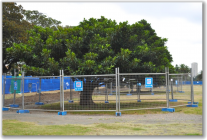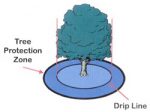As cities expand, wooded lands and property with mature trees are being developed into commercial and residential sites. Unfortunately, the construction process can be deadly to nearby trees. In most cases, the trees don’t die immediately. Several years later as symptom development occurs in the declining trees, most people don’t associate it with the previous construction.
However, it is possible to preserve trees on building sites if the right measures are taken. Trees and their root systems must be protected from damage during the construction process. Roots absorb the water and nutrients that are essential to tree health. Damage to the roots can lead to the death of a tree. Compaction of the soil from equipment operation can hinder the tree’s absorption of nutrients.
 The single most important action is to set up sturdy construction fences around the tree. The fence should be placed at least at the dripline of the tree’s canopy. As a general guideline, allow 1 foot from the trunk for each inch of the trunk diameter. Even with this method, 50% or more of the roots will be impacted by construction. No vehicles, building materials, waste, or soil should be allowed within the fenced area. No digging, trenching, or soil disturbance should be performed in that space. If construction equipment is allowed to operate close to the fencing, root pruning should be performed. A 4-5 inch deep trench should be dug on the outside of the tree protection zone with an air spade and then cut the roots cleanly with a saw. This root pruning technique will limit extensive damage to the roots.
The single most important action is to set up sturdy construction fences around the tree. The fence should be placed at least at the dripline of the tree’s canopy. As a general guideline, allow 1 foot from the trunk for each inch of the trunk diameter. Even with this method, 50% or more of the roots will be impacted by construction. No vehicles, building materials, waste, or soil should be allowed within the fenced area. No digging, trenching, or soil disturbance should be performed in that space. If construction equipment is allowed to operate close to the fencing, root pruning should be performed. A 4-5 inch deep trench should be dug on the outside of the tree protection zone with an air spade and then cut the roots cleanly with a saw. This root pruning technique will limit extensive damage to the roots.
The next step that will help the survival of a protected tree is irrigation during the construction phase. Stressed trees need plenty of water throughout the process. This means watering each tree about 2-3 times per week to a soil depth of 4-6 inches. Additionally, an application of 3 inches of organic mulch within the tree protection zone would help maintain soil moisture. But, do not place mulch against tree trunks because it could cause fungus growth to the trunk. If roots are not pruned at the edge of the protection zone, mulch should be placed over any roots that could possibly be driven over to reduce compaction.
Following construction the fencing can be removed, but irrigation needs to continue. However, the frequency should be reduced while the duration needs to be increased, to ensure that the tree receives enough water to maintain moisture in the top 12-18 inches of soil for the next year.
Simply keeping a tree on site does not mean it will survive the construction process. If measures to protect the tree cannot be taken, the most practical approach is to remove the tree prior to construction. But, for some of the historical mature trees it is probably worth the effort to preserve some horticultural heritage of the area.
 0
0
